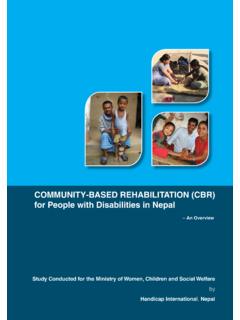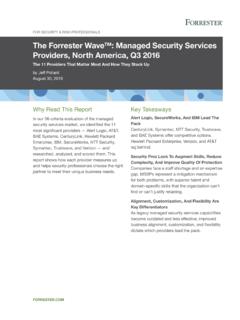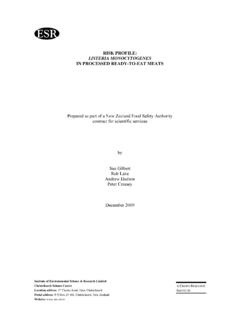Transcription of INCLUSIVE EDUCATION Main Paper - hiproweb.org
1 INCLUSIVE EDUCATION : ACHIEVING EDUCATION FOR ALL BY INCLUDING THOSE WITH DISABILITIES AND SPECIAL EDUCATION NEEDS SUSAN J. PETERS, * PREPARED FOR THE DISABILITY GROUP THE WORLD BANK April 30, 2003 The findings, interpretations and conclusions expressed in this report are entirely those of the author and should not be attributed in any manner to the World Bank, to its affiliated organizations, to members of its Board of Executive Directors, or to the countries they represent. The report has gone through an external peer review process, and the author thanks those individuals for their feedback. *Susan J. Peters is an Associate Professor in the College of EDUCATION , Michigan State University, East Lansing, Michigan, USA. She has been an educator and disability scholar for the past 20 years and has published in various international journals.
2 She is the co-author and editor of two books: EDUCATION and Disability in Cross-Cultural Perspective (NY: Garland Publishing. 1993) and Disability and Special Needs EDUCATION in an African Context (Harare: College Press. 2001). She may be contacted at TABLE OF CONTENTS INCLUSIVE EDUCAITON: ACHIEVING EDUCATION FOR ALL BY INCLUDING THOSE WITH DISABILITIES AND SPECIAL EDUCATION NEEDS Glossary of Terms Executive Summary 1 I. Introduction 9 Background II. INCLUSIVE EDUCATION Practice: Lessons from the north 18 Background Best Practice in Canada and the United States Best Practice in Europe and other OECD Countries Special Issues: Accountability Special Issues: Parental Involvement Special Issues: Gender Summary III. INCLUSIVE EDUCATION Practice: Lessons from the South 26 Introduction IE: The Experience of Southern Hemisphere School System INCLUSIVE EDUCATION Framework Challenges and Responses to IE in the South Barriers Gaps in the Literature Considerations for Future Study Zambia Honduras Vietnam India Summary IV.
3 Economic Issues 47 Introduction/Background Governmental Funding Formulas Cross-cutting Characteristics of Funding Models Criteria for Evaluating Special EDUCATION Funding Formulas Cost-Saving Measures to Resource INCLUSIVE EDUCATION Summary V. Legal Issues: Progress towards the right to INCLUSIVE EDUCATION 57 Introduction/Background The current situation: Conventions, Declarations and Standard Rules Legislative/Policy Progress towards INCLUSIVE EDUCATION Promoting Rights to INCLUSIVE EDUCATION Summary/Recommendations VI: Policy/Practice Implications 64 Conclusion: EDUCATION For All Together ANNEXES Annex 1: Classifications of Disability and Notes on Definitions 75 Annex 2: Sources for Information on Disability, INCLUSIVE EDUCATION and Human Rights 76 Annex 3: Declarations 77 REFERENCES Chapter I: Introduction 86 Chapter II: Lessons from the north 88 Chapter III: Lessons from the South 90 Chapter IV: Economic Issues 93 Chapter V.
4 96 BIBLIOGRAPHIES Spanish Language Literature French Language Literature Annotated English Language Literature ---------------------------------------- -------- The author wishes to thank and acknowledge the following individuals for their assistance with this report: Carolyn Carpenter, American Institutes for Research William Divers, Michigan State University Pamela Dudzik, Disability Group/The World Bank Judy Heumann, Disability Group/The World Bank Christopher Johnstone, National Center for Educational Outcomes Shirley Miske, Miske Witt & Associates Penelope Price, Rehabilitation International Diane Prouty, American Institutes for Research Robert Prouty, The World Bank Diane Richler, Inclusion International Carlos Skliar, Universidade Federal do Rio Grande do Sul Sue Stubbs, International Disability & Development Consortium Leah Wasburn-Moses.
5 Michigan State University GLOSSARY OF TERMS ADB Asian Development Bank AIR American Institutes for Research CAS Country Assistance Strategy CBR Community Based Rehabilitation CRC Convention on the Rights of the Child CERI Centre for Educational Research and Innovation CSIE Centre for Studies on INCLUSIVE EDUCATION DESA Department of Economic and Social Affaires (United Nations) DPEP District Primary EDUCATION Program DPI Disabled People s International DPO Disabled Peoples Organization EFA EDUCATION for All ESCAP Economic and Social Commission for Asia and the Pacific ICF International Classification of Functioning and Disability ICIDH-2 International Classification of Functioning and Disability IDA International Disability Alliance IDEA Individuals with Disabilities EDUCATION Act IE INCLUSIVE EDUCATION IEP Individualized EDUCATION Program ISCED International Standard Classification of EDUCATION MDG Millennium Development Goals NCERI National Centre on Educational Restructuring and Inclusion NCERT National Council for Educational Research and Training OECD Organization of Economic Co-operation and Development PER Program Effectiveness Review PIED Project Integrated EDUCATION for the Disabled PRSP Poverty
6 Reduction Strategy Paper SEN Special EDUCATION Needs SIEDC Scheme for Integrated EDUCATION of Disabled Children SNE Special Needs EDUCATION UNICEF United Nations Children s Fund UNESCO United Nations Educational, Scientific and Cultural Organization UNCRC United Nations Convention on the Rights of the Child UPE Universal Primary EDUCATION WHO World Health Organization 1 INCLUSIVE EDUCATION : Achieving EDUCATION for All by Including those with Disabilities and Special EDUCATION Needs Executive Summary I. Introduction In a report for UNICEF, Bengt Lindqvist, the United Nations Special Rapporteur on Human Rights and Disability, provided the following challenge: A dominant problem in the disability field is the lack of access to EDUCATION for both children and adults with disabilities. As EDUCATION is a fundamental right for all, enshrined in the Universal Declaration of Human Rights, and protected through various international conventions, this is a very serious problem.
7 In a majority of countries, there is a dramatic difference in the educational opportunities provided for disabled children and those provided for non-disabled children. It will simply not be possible to realize the goal of EDUCATION for All if we do not achieve a complete change in the situation. Addressing this widely recognized need for change, the Dakar Framework for Action adopted a World Declaration on EDUCATION for All (EFA) in 2000, which affirmed the notion of EDUCATION as a fundamental right and established the new millennium goal to provide every girl and boy with primary school EDUCATION by 2015. EFA also clearly identified INCLUSIVE EDUCATION as one of the key strategies to address issues of marginalization and exclusion. The fundamental principle of EFA is that all children should have the opportunity to learn. The fundamental principle of INCLUSIVE EDUCATION is that all children should have the opportunity to learn together.
8 Significant numbers of disabled children and youth are largely excluded from educational opportunities for primary and secondary schooling. Exclusion, poverty and disability are linked. EDUCATION is widely recognized as a means to develop human capital, to improve economic performance, and to enhance people s capabilities and choices. Exclusion from EDUCATION can result in a staggering loss of freedom and productivity in the labor market. The international community (at least at the policy level) has recognized EDUCATION as a fundamental child right and has committed to a framework for action to address this right, and to redress exclusion as directed by EFA 2000. INCLUSIVE EDUCATION in the context of the goals of EDUCATION for All is a complex issue, and no coherent approach is evident in the literature. First, at a basic level of policy, unlike health and labor markets, disability is seen as an array of issues crossing health, EDUCATION , social welfare, employment sectors, etc.
9 As a result, policy development in relation to individuals with disabilities faces challenges to avoid fragmented, uneven, and difficult-to-access services. Second, INCLUSIVE EDUCATION may be implemented at different levels, embrace different goals, and be based on different motives, reflect different classifications of special EDUCATION needs (SEN), and provide services in different contexts. Specific goals may focus either on improved educational performance and quality of EDUCATION , or on autonomy, self-determination, proportionality, consumer satisfaction or parental choice. Some of these goals may conflict and produce tensions. Similarly, motives for INCLUSIVE EDUCATION may derive from dissatisfaction with the system, from economic or resource allocation concerns, or from a vision of educational reform. Finally, SEN services may be viewed as a continuum of placement options (multi-track approach), as a distinct EDUCATION system (two-track approach) or as a continuum of services within one placement the general EDUCATION school and classroom (one-track approach).
10 All of the variants produced by these different aims, levels, systems and motives may be called INCLUSIVE EDUCATION . In order to understand exclusion and strategies for working toward inclusion, it is necessary to examine research on policy and practice at the micro-level (schools and communities), at the meso-level (educational systems and external agency support services), and at the macro-level (national/international policy and national legislation). 2 II. INCLUSIVE EDUCATION Practice Lessons from the north Large-scale cross-national studies in countries of the north provide extensive information on best practice for INCLUSIVE EDUCATION . A high priority involves teacher training, perhaps not surprisingly, due to the fact that personnel resources constitute approximately 80% of all school expenditures. All of the studies cited recommend that teacher training focus on enhancing the skills of classroom teachers in areas of pedagogy, curriculum development and adaptation.






